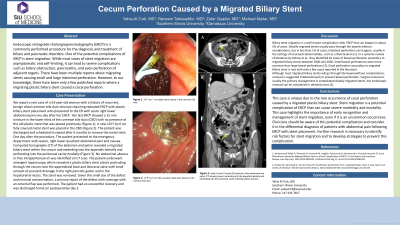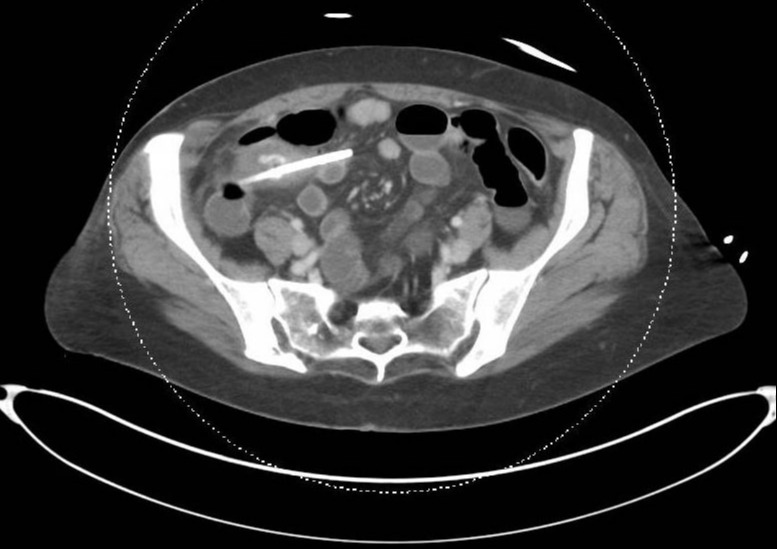Monday Poster Session
Category: Interventional Endoscopy
P2342 - Cecum Perforation Caused by a Migrated Biliary Stent
Monday, October 23, 2023
10:30 AM - 4:15 PM PT
Location: Exhibit Hall

Has Audio

Yahia Al Turk, MD
Southern Illinois University
Springfield, IL
Presenting Author(s)
Yahia Al Turk, MD1, Raneem Takkeaddin, MD2, Zafar Quader, MD1, Michael Maitar, MD1
1Southern Illinois University, Springfield, IL; 2Damascus University, Springfield, IL
Introduction: Endoscopic retrograde cholangiopancreatography (ERCP) is a commonly performed procedure for the diagnosis and treatment of biliary and pancreatic disorders. One of the potential complications of ERCP is stent migration. While most cases of stent migration are asymptomatic and self-limiting, it can lead to severe complications such as perforation, even distally in the gastrointestinal tract. There have been multiple reports about small and large intestinal perforation caused by biliary stent migration, however, there are only a few reports about plastic biliary stents migrating and causing cecal perforation.
Case Description/Methods: We report a rare case of a 53-year-old woman with a history of a benign distal common bile duct stricture who underwent ERCP with plastic biliary stent placement. The patient presented to the emergency department 6 weeks after stent placement with severe right lower quadrant abdominal pain and nausea. Computed tomography (CT) of the abdomen and pelvis revealed a migrated biliary stent within the cecum extending into the appendix laterally and perforating into the peritoneal cavity medially. No abdominal abscess or free intraperitoneal air was identified on the CT scan. The patient underwent emergent laparoscopy, which revealed a plastic biliary stent protruding through the cecum near the appendiceal base and ileocecal valve with a small amount of purulent drainage in the right pericolic gutter and in the hepatorenal recess. The stent was removed. Given the proximity of the defect to the ileocecal valve as well as the small size of the defect with minimal contamination, a primary repair of the defect with coverage with an omental flap was performed. The patient had an uneventful recovery and was discharged home on postoperative day 2.
Discussion: This case is unique due to the rare occurrence of cecal perforation caused by a migrated plastic biliary stent. Stent migration is a potential complication of ERCP that can cause severe morbidity and mortality. This case highlights the importance of early recognition and management of stent migration, even if it is an uncommon occurrence. Clinicians should be aware of this potential complication and consider it in the differential diagnosis of patients with abdominal pain following ERCP with stent placement. Further research is necessary to identify risk factors for stent migration and to develop strategies to prevent this complication.

Disclosures:
Yahia Al Turk, MD1, Raneem Takkeaddin, MD2, Zafar Quader, MD1, Michael Maitar, MD1. P2342 - Cecum Perforation Caused by a Migrated Biliary Stent, ACG 2023 Annual Scientific Meeting Abstracts. Vancouver, BC, Canada: American College of Gastroenterology.
1Southern Illinois University, Springfield, IL; 2Damascus University, Springfield, IL
Introduction: Endoscopic retrograde cholangiopancreatography (ERCP) is a commonly performed procedure for the diagnosis and treatment of biliary and pancreatic disorders. One of the potential complications of ERCP is stent migration. While most cases of stent migration are asymptomatic and self-limiting, it can lead to severe complications such as perforation, even distally in the gastrointestinal tract. There have been multiple reports about small and large intestinal perforation caused by biliary stent migration, however, there are only a few reports about plastic biliary stents migrating and causing cecal perforation.
Case Description/Methods: We report a rare case of a 53-year-old woman with a history of a benign distal common bile duct stricture who underwent ERCP with plastic biliary stent placement. The patient presented to the emergency department 6 weeks after stent placement with severe right lower quadrant abdominal pain and nausea. Computed tomography (CT) of the abdomen and pelvis revealed a migrated biliary stent within the cecum extending into the appendix laterally and perforating into the peritoneal cavity medially. No abdominal abscess or free intraperitoneal air was identified on the CT scan. The patient underwent emergent laparoscopy, which revealed a plastic biliary stent protruding through the cecum near the appendiceal base and ileocecal valve with a small amount of purulent drainage in the right pericolic gutter and in the hepatorenal recess. The stent was removed. Given the proximity of the defect to the ileocecal valve as well as the small size of the defect with minimal contamination, a primary repair of the defect with coverage with an omental flap was performed. The patient had an uneventful recovery and was discharged home on postoperative day 2.
Discussion: This case is unique due to the rare occurrence of cecal perforation caused by a migrated plastic biliary stent. Stent migration is a potential complication of ERCP that can cause severe morbidity and mortality. This case highlights the importance of early recognition and management of stent migration, even if it is an uncommon occurrence. Clinicians should be aware of this potential complication and consider it in the differential diagnosis of patients with abdominal pain following ERCP with stent placement. Further research is necessary to identify risk factors for stent migration and to develop strategies to prevent this complication.

Figure: A biliary stent within the cecum perforating into the peritoneal cavity medially.
Disclosures:
Yahia Al Turk indicated no relevant financial relationships.
Raneem Takkeaddin indicated no relevant financial relationships.
Zafar Quader indicated no relevant financial relationships.
Michael Maitar indicated no relevant financial relationships.
Yahia Al Turk, MD1, Raneem Takkeaddin, MD2, Zafar Quader, MD1, Michael Maitar, MD1. P2342 - Cecum Perforation Caused by a Migrated Biliary Stent, ACG 2023 Annual Scientific Meeting Abstracts. Vancouver, BC, Canada: American College of Gastroenterology.
